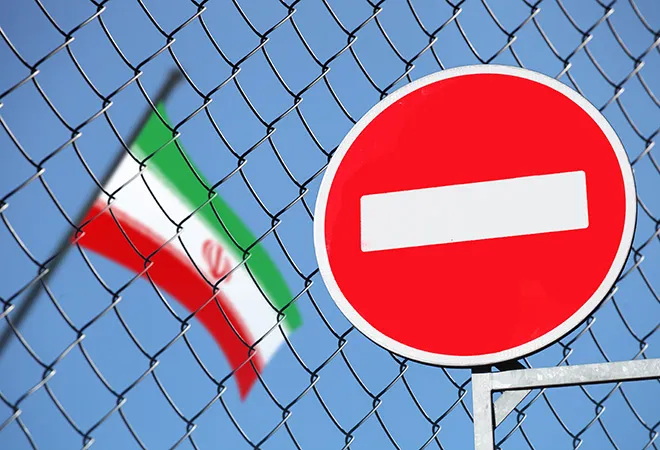-
CENTRES
Progammes & Centres
Location
Whether the escalation of conflict between the US and Iran can be calibrated or not, is difficult to predict.

The Joint Comprehensive Plan of Action (JCPOA), more often referred to as the ‘Iran Nuclear Deal’ is on its last legs in the ICU. US dealt it a mortal blow on 8 May last year when President Donald Trump announced a unilateral withdrawal from the JCPOA, calling it a “horrible, one-sided deal that should never, ever have been made.” Other parties to the P5+1 Iran deal (China, France, Germany, Russia, UK and EU) rejected the US charge and declared their commitment to preserving the JCPOA. However, under ‘maximum pressure’ exerted by the US and E3/EU failure to make good on its promise of providing economic transfusions will soon lead to the JCPOA’s demise.
After waiting for one year, President Hassan Rouhani issued a 60 day ultimatum on 8 May to the Europeans that if they were unable to make good on their assurances of ensuring sanctions relief, Iran would no longer observe the JCPOA constraints on its nuclear programme. On 1 July, Iranian Foreign Minister Javad Zarif announced that Iran had exceeded the ceiling of 300 kgms of stockpile of low enriched uranium. He added that after ten days, Iran would no longer observe the enrichment limit of 3.67% imposed by the JCPOA. The JCPOA had already been in the ICU and these developments are the equivalent of pulling the plug on the life support systems, one by one.
President Trump accused Iran of ‘playing with fire’ while the European countries have voiced expressions of regret while urging Iran ‘to stick to its commitments’. Indirectly blaming the US, Russia called it ‘a natural consequence of recent events’. Israel has condemned the Iranian decision describing it as ‘an attempt to blackmail the international community’ and asked the EU to impose sanctions on Iran.
After the announcement last year, the US has methodically moved to re-impose the sanctions that had been waived with the conclusion of the JCPOA in 2015 and gradually tightened them further. By last November, the sanctions had kicked in except that eight countries (China, Greece, India, Italy, Japan, South Korea, Taiwan and Turkey) were permitted to continue imports of Iranian oil for a period of six months as long as they showed significant reductions. This temporary waiver ended on 2 May.
Meanwhile, the US designated the IRGC as ‘a terrorist organisation’. Since the IRGC has considerable economic interests, this has brought Iran into the FATF’s crosshairs. In May, additional sanctions were imposed on Iran’s industrial metal (iron, steel, aluminium and copper) industry, the second largest export earner. Exports of low enriched uranium and heavy water were barred (leading Iran to announce that would no longer observe the JCPOA ceilings). On 24 June, the US announced sanctions on senior Iranian leaders including Supreme Leader Ayatollah Khamenei.
Iranian disappointment with the E3/EU has been growing. After months of negotiations, the Instrument for Supporting Trade Exchanges (INSTEX) was finally unveiled by the EU. It was made clear that oil exports were excluded and INSTEX would only deal with humanitarian trade (medicines, medical equipment, agricultural goods and food items). In April, a counterpart entity STFI (Special Trade and Finance Instrument) was set up in Tehran. These two entities are designed to permit barter through parallel book-keeping though no transaction has taken place yet. Iranian Oil Minister Bijan Zanganeh said that ‘without a secured deposit, INSTEX will not work with just three or four million euros and oil money needs to be deposited in it’. Meanwhile, the growing number of sanctioned persons/entities in the US list of Specially Designated Nationals makes INSTEX operations more tricky with regard to ensuring compliance. INSTEX’s founding partners (France, Germany and UK) express hope that its ownership and operations can be expanded over time beyond EU members to include Iran’s other major trading partners like India, Turkey, Russia and China though prospects are remote, given the anaemic nature of INSTEX.
Last year, Iran adopted ‘strategic patience’ but it is clearer that this is not helping. President Trump is likely to get another term and the Europeans have failed to deliver. Iran’s move is a signal to the E3/EU that its patience is running out and it will not renegotiate with the US under ‘maximum pressure’. For the EU, it is an opportunity to demonstrate that it is a credible political actor and the Common Foreign and Security Policy counts for more than pious pronouncements. While the decision to exceed the 300 kgms ceiling does not constitute a proliferation risk, the next step of resuming enrichment beyond 3.67% is more significant. In weeks, the IAEA will conclude that Iran is reversing the constraints of the JCPOA, thereby confirming its demise.
Since May, the US has beefed up its military presence in the Persian Gulf region. The USS Abraham Lincoln aircraft carrier strike task force was deployed in early May, followed by USS Arlington (a transport vessel for amphibious vehicles) and a Patriot missile defence battery. Tensions began to rise with four oil tankers just outside the Straits of Hormuz reporting sabotage on 12 May. On 13 June, two tankers were targeted in the Gulf of Oman. Iran has denied allegations of any involvement. A week later a Global Hawk surveillance aircraft was downed by Iran, claiming it had intruded into Iranian airspace and refused to heed warnings to exit. A retaliatory air strike by the US on Iranian anti-aircraft batteries on 21 June was called off at the last minute by President Trump when he learnt that it could lead to a loss of 150 lives and felt that this would be a ‘disproportionate’ response
What happens next is uncertain. Iran will seek to build up leverages before it agrees to engage in a fresh negotiation. This will be achieved partly by rebuilding capability in the nuclear field and partly by using its influence in the region (Afghanistan, Iraq, Yemen and Syria). Both the US and Iran claim that neither wants conflict but whether the growing escalation can be calibrated or events slip out of control will be difficult to predict.
The views expressed above belong to the author(s). ORF research and analyses now available on Telegram! Click here to access our curated content — blogs, longforms and interviews.

Ambassador Rakesh Sood was a Distinguished Fellow at ORF. He has over 38 years of experience in the field of foreign affairs economic diplomacy and ...
Read More +